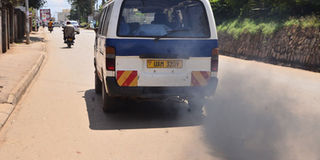KCCA gets USA’s hand to clean city’s air

Smoke. A vehicle under dangerous mechanical condition emits smoke in Kampala last week. PHOTO BY ALEX ESAGALA
What you need to know:
Plan. An air quality management programme is to be set up to build the capacity of KCCA technical team.
A smoke-emitting taxi from the Old Taxi Park makes its way through traffic jam on Namirembe Road.
As it proceeds towards Qualicel Arcade, traffic grows thicker and it gets stuck.
The smoke it emits spreads all over the area, choking occupants of other cars stuck in jam.
This is a common experience on most of the city’s busy roads such as Kampala, Jinja and Bombo roads, which are occasionally used by hundreds of motorists, making traffic gridlock inevitable.
Trapped in such environmental hazard, Kampala Capital City Authority (KCCA) is frantically moving to break the status quo.
They have unveiled deterrent measures to mitigate air pollution.
Daily Monitor has established that KCCA is now packaging a programme to implement immediate actionable points such as establishing a multi-stakeholder air quality working group for Kampala city in collaboration with several agencies.
According to the plan, the working group will coordinate efforts to further strengthen monitoring and develop interventions to improve air quality in the city.
Additionally, the team will sensitise the public on practical steps to limit air pollution such as driving less and encourage walking, and proper disposal of garbage, among others.
Ms Jennifer Musisi, the KCCA’s executive director, says to ably develop regulations and laws that can contain city pollution, the Authority requires the development of an adequate air quality monitoring and management system.
“KCCA is working with Makerere University Software Development Centre to develop tools, plus the school of Public Health Makerere University to monitor air quality around the city. These efforts are financed under the Kampala Climate Change project supported by the European Union,” she says.
Air quality management
Ms Musisi notes that the US is supporting KCCA to set up an air quality management programme by building the capacity of its technical team.
Some of the training includes air data visualisation, and the application of air pollution data. But she does not reveal how much money will be used to install air monitoring tools.
In February this year, this newspaper reported that Kampala tops the list for cities with the most polluted air in East, Central and Southern Africa. Here, 90 minutes of exposure to the fumes are enough to cause damage to your health.
Other cities in Africa with poor air, the story revealed, include Bamenda in Cameroon, where 45 minutes on the road are enough to cause harm.
The same story quoted Dr Bruce Kirenga, the lead investigator and Director Lung Institute Mulago hospital, who revealed that inhaling this polluted air causes oxidative stress.
“At the end of the day, they disorganise the functioning of the cells. So, the cells behave abnormally, they develop cancer, the cells are damaged and when they heal, they develop fibrosis,” he said.
A recent World Bank report on the role of cities revealed that the existing roads in Kampala were constructed in the 1960s to accommodate only 100,000 vehicles.
However, the report notes that at least 400,000 vehicles use Kampala roads every day.
The significant increase in the number of vehicles, the report says, explains Kampala’s heavy traffic jam.
The cars exhaust fumes coupled with the stench from Kampala’s drainage channels and solid waste, and smoke from industries around the city some of which are located in the same vicinity with residential area. This dilutes Kampala’s air quality.
For instance, the Industrial area in Namuwongo, is surrounded by suburbs like Wabigalo, which inhabit several urban dwellers.
Such uncoordinated planning in both transport, housing and industrialisation which produce toxic air, leaves urban dwellers perpetually on tenterhooks, and while they inhale the toxic air, they slowly breath themselves to the grave.
More information gathered by this newspaper further shows that air pollution in Kampala is triggered by open smoking, dust from unpaved roads, fumes from cars and open burning of waste.
On September 5, Kampala’s air quality which was measured at Nsambya, a city suburb, by the Air Pollution Monitor was found to be dangerous for human consumption.
It was found out to be six times higher 162(g/m3) than World Health Organization Air Quality Guidelines 25(g/m3).
The concentration of an air pollutant is given in micrograms per meter or g/m3.
The Air Quality Index scale as defined by the Unites States of America Environmental Protection Agency’s 2016 standards indicates that readings below 50(g/m3) show that the air quality is good with little or no health risk.
The findings further show that although some cities are
heavily industrialised, they have better air quality than that of Kampala yet it has less industries.
Kampala city was also found ou
t to have a high concentration of tinny air particles which are small enough to invade the smallest airwaves.
Health experts warn that exposure to contaminated air may narrow or block blood vessels and could lead to a heart attack, chest pain, stroke, or other respiratory diseases such as asthma, chronic bronchitis, lung cancer, and pneumonia.
Amanda Ngabirano, a Planning expert, who teaches Urban Planning at Makerere University, says the plans by KCCA to combat air pollutions is welcome.
But to effectively weed out the triggers of air pollution, Ms Ngabirano says that the city needs energy efficient systems, clean fuel, solar vehicles and public means of transport to reduce on the number of private cars that partly contribute to poor air quality.
“Industries must be cautiously located in appropriate zones to reduce high levels of carbon, and maintain green spaces and trees in the city,” she says.
Last month, a team from KCCA, National Environment Management Authority (Nema) and Makerere University led by KCCA’s deputy executive director Samuel Serunkuuma visited an air quality monitoring plant in the department of Environmental Quality in Detroit, Michigan to understand how it works and how to apply the same in Kampala.
Mr Paul Sajjabi, the KCCA’s environmental project officer, says once the Memorandum of Understanding (MoU) with partners is signed, then air monitoring tools will be installed in the city.
“A decision will be taken on where to install the air monitoring tools by the consultant who is already working on all the plans. We expect to have a baseline by November this year,” he said.
According to the Journal of Environmental and Public Health published in February 2014, Nema estimated that about 140,000 litres of fuel are burnt by idling cars every day worth Shs500m.
Air pollution is one of the leading preventable causes of death in the world, killing nearly seven million people a year mostly in urban areas. Indoor air pollution is responsible for roughly half those deaths.
Ambient air pollution, made of high concentrations of small and fine particulate matter, is the greatest environmental risk to health causing more than three million premature deaths worldwide every year.



